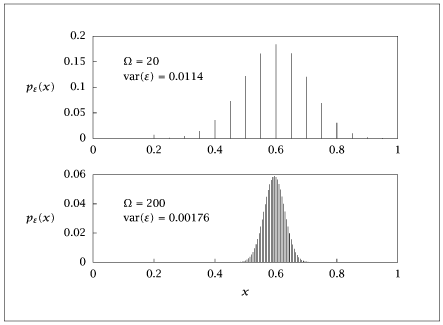import numpy as np
import matplotlib.pyplot as plt
from scipy.linalg import expm
def simulate_system(Vol):
x = np.array([1, 5, 0]) * Vol
nmol = x[0]
k = np.zeros(2)
k[0] = 1 / Vol
k[1] = 3
extent = np.linspace(1, 0, num=int(nmol+1))
A = np.zeros((int(nmol+1), int(nmol+1)))
for i in range(int(nmol+1)):
n = i
nu = nmol - n
a = n
b = x[1] - nu
c = nu
A[i, i] = -(k[0] * a * b + k[1] * c)
if i > 0:
A[i, i-1] = k[1] * (c+1)
if i < nmol:
A[i, i+1] = k[0] * (a+1) * (b+1)
p = np.zeros(int(nmol+1))
p[-1] = nmol
deltat = 0.01
tfinal = 1
time = np.arange(0, tfinal + deltat, deltat)
Ad = expm(A * deltat)
for t in time:
p = Ad @ p
p = p / p.sum() * nmol
peq = p / nmol
table = np.column_stack((extent, peq))
return table
table_small = simulate_system(20)
table_large = simulate_system(200)
plt.figure()
plt.plot(table_large[:,0], table_large[:,1],'^')
plt.figure()
plt.plot(table_small[:,0], table_small[:,1],'^')
plt.show(block=False)
with open('prob_dis_scale.dat', 'w') as f:
# First block: Mean square displacement
np.savetxt(f, table_small, fmt='%f', header="table_small")
f.write("\n\n")
np.savetxt(f, table_large, fmt='%f', header="table_large")
